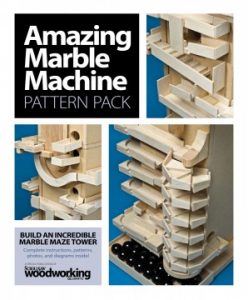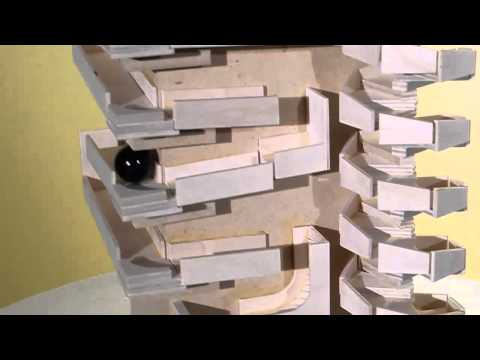Richard Browne’s marble machine is a mesmerizing artwork and an example of engineering at its best
As he tells the story, Richard Browne has been an engineer in training since he was a child. “ At age five I learned about electricity–by sticking jacks in the outlet,” said Richard with a laugh. “My grandfather, whose house we lived in, wasn’t too happy about that, but I determined right there and then I was going to find out what caused the spark that flew up the walls. That got me interested in electricity.”
At age five I learned about electricity–by sticking jacks in the outlet,” said Richard with a laugh. “My grandfather, whose house we lived in, wasn’t too happy about that, but I determined right there and then I was going to find out what caused the spark that flew up the walls. That got me interested in electricity.”
A year later, six-year-old Richard visited the 1939 New York World’s Fair, where his father worked in the transportation building, and saw two more pieces of inspiration: an enormous model railroad layout and a marble machine. “To this day, I could probably draw a very detailed picture of what [that marble machine] looked like,” said Richard. “That fascinated me, to the point where I said, ‘I want to build one of those,’ and I’ve been building them ever since.”
Richard built a lot of small marble rollers as he grew up, nailing a few boards together and drilling holes. His grandfather used the activity to teach woodworking. “My grandfather was a master carpenter, and he started teaching me to use tools as soon as I was old enough to hold them,” said Richard. “I learned how to work with planes and saws. He taught me to be able to cut a board off with a handsaw so straight that you could stand it on end and it would stand up. I’ve done woodworking ever since.”
After learning carpentry by making ramps with his grandfather, Richard built his first marble machine at age 14. He still has the machine, although he has replaced lost and broken pieces over the years. A conglomeration of ramps, levers, and string, the machine originally used 20 marbles to run for about six minutes; the current version runs for three minutes.
As an adult Richard started a second, much more complex machine. He built the stand and frame about two decades ago, plus a 24-channel marble gate. “And then I stopped. That thing just sat and gathered dust in the basement until about two or three years ago. And then I thought, boy, I’ve got to get that out and start working on it again.”
After a busy couple of years, the machine is 52″ tall and comprises a series of assemblies including elevators, an anti-gravity hill, a scissors jack, and a Ferris wheel. When finished, the machine will take 24 hours to move a marble from the bottom to the top and back down again; the marble will travel nearly 12 miles. Many of the assemblies are removable to make it easy to work on the overall machine and to test the separate gadgets.
Richard built his third machine in 2008 as a Christmas gift for his granddaughter, Natalie. Much smaller and simpler than his other two machines, it is 24″ tall and uses 13 marbles. Richard built it after seeing a small plastic machine in a toy catalog. He thought it was neat, but that he could build something better. “So, six weeks before Christmas, I started by cutting out four sides, just making it up as I was going along. I made a bucket thing, a chute-to-chute thing, and a gate inside so the marble went one way one time and the other way the next time, and I made a thing at the top that held 13 marbles and released them one at a time.” The machine runs for several minutes because each marble that reaches the bottom triggers the release of another marble at the top.
Using Natalie’s machine as inspiration, Richard recently designed a marble machine exclusively for Scroll Saw Woodworking & Crafts. The plans are available in a printed pattern pack or via download at www.scrollsawer.com. The machine is nearly three feet tall, holds 26 marbles, and runs for about six minutes. Like Natalie’s machine, it has two tracks and each marble triggers the release of the next. A complicated piece of engineering designed to exact tolerances, it runs with a pleasing clatter as the 1″ marbles roll, spiral, and swoop through nearly 18′ of track.
Despite a lifetime’s worth of experience, Richard says he designs his marble machines using “seat-of-the-pants engineering. A lot of it would take trigonometry and calculus, and I do some of that, but when it came to questions like, what angle does this need to be for the marble to roll down reliably, it’s easy—I just go in the shop, clamp a piece of wood in the vise, clamp a track to it, and roll the marble down it.” To develop a project, he sketches a idea and then heads to the shop. “I’ve got lots of scrap wood and lots of tools, so I’ll just go in there and start cutting pieces and saying now, this is what I want, something that does this and this. I’ll try it out and see it would have worked better if I had made this piece smaller and that one longer. So I’ll rip it off or I’ll make another one and just keep doing that until, wow, it’s working.”
Richard combines this experimentation with precision. For example, he measured 130 marbles to within thousandths of an inch and realized they tend to be oblong rather than round. Then, he adjusted the ramps until even the least round marble would roll and set the slope at 4°. He drilled the holes in the SSWC machine’s body slightly larger than the marble size to account for possible wood swelling and sloped them to ensure the marbles wouldn’t stop rolling as they passed in and out of the machine. While developing a prototype weight for the dump bucket, he counted the exact number of lead BBs required to fill a hollow dowel and create the necessary swing—and then discarded the design for fear woodworkers would have a different type of BB and be unable to duplicate his success with the design.
The elegant SSWC machine is just one example from a lifetime of engineering experiments. As a teenager, Richard built a model train layout; a “bedside control stand” featuring a record player, a radio, a clock, and “a whole bunch of outlets and switches that did everything;” as well as a mousetrap that was supposed to shoot the mouse with a bow and arrow. (He never caught a mouse because his mother didn’t think it was a good idea.) Richard remembers roaming New York City as a pre-teen and buying chemicals to build a rocket, which, when set off on Easter morning, went unfortunately awry and burned a hole in his mother’s church dress. (She wasn’t injured, he said, but she was very angry.) “I was very curious about everything,” he said. “I took radios apart, I took clocks apart, put them back together … working with my hands, it’s what I’ve done all my life.”
As a young adult, Richard joined the Army and was trained in microwave radios. His commitment ended in 1957, and he then chose a job installing early computers instead of going to college. A few years later, Richard applied at Bell Labs outside Philadelphia, which only hired engineers with master’s degrees. Richard didn’t have a degree, but he did have two cars that he had equipped with remote control: a 1958 Ford that he could start and turn on the heater, and a 1960 Buick that he could actually drive remotely. “When I went in for my interview, I took in diagrams of how I built my [Buick], and the interviewer was so fascinated he wanted to see it. So we went out to the parking lot and I drove it around the parking lot for him. He just couldn’t believe it. It was made with a lot of surplus telephone relays, which is what Bell Labs did. … And so they gave me a job as a junior technician.”
Richard enjoyed a 40-year-long career as an engineer and technical writer for various companies, as well as a freelance engineering consultant. “Mechanical and electronic engineering, and electrical, and hydraulic—I did a little bit of everything,” he said. He remembered a few outstanding projects, including building his own computer from surplus telephone relay equipment, creating a mechanical weather map for a television station, designing circuit boards for the space shuttle, and making a pumpkin-shooting cannon from a 20″-diameter PVC pipe.
A tinkerer and perfectionist at heart, Richard noted that he could have made the SSWC machine more complex, perhaps by adding some swoops, turns, or spins to the second track. And, he mused, the corner blocks aren’t quite perfect—later experiments showed that adding a thicker curb would have made the marble travel its path slightly more successfully. But as the marbles rattle down the ramps, around the curves, and through the zigzags and spiral staircase, the machine is both a mesmerizing artwork and a homemade, self-taught example of engineering at its best.
To see Richard Browne’s marble machines in action, check out the video here. The SSWC marble machine pattern pack is available for $9.99. Click here to purchase a printed pattern pack, or to buy the electronic version and start making your own machine today.







